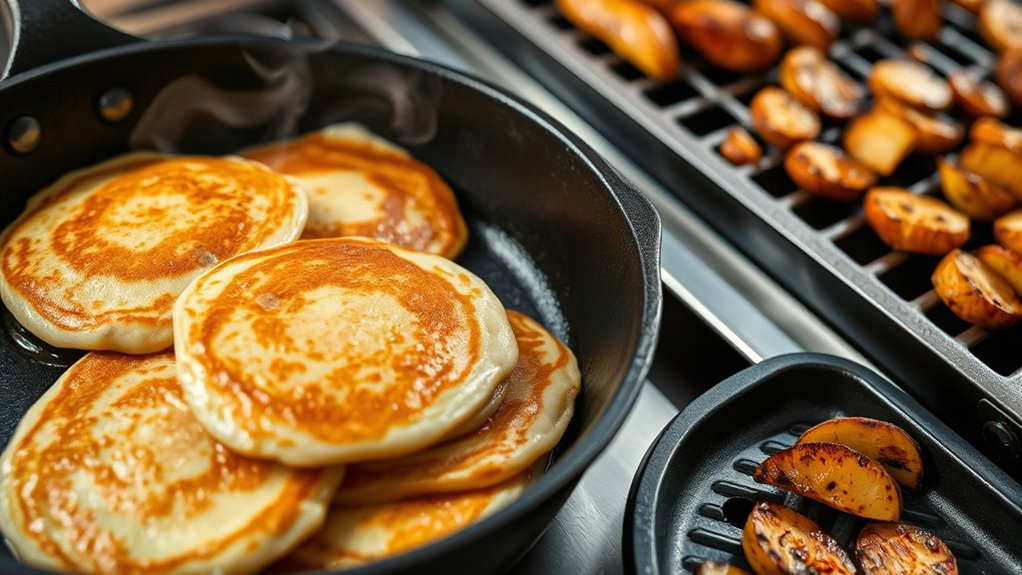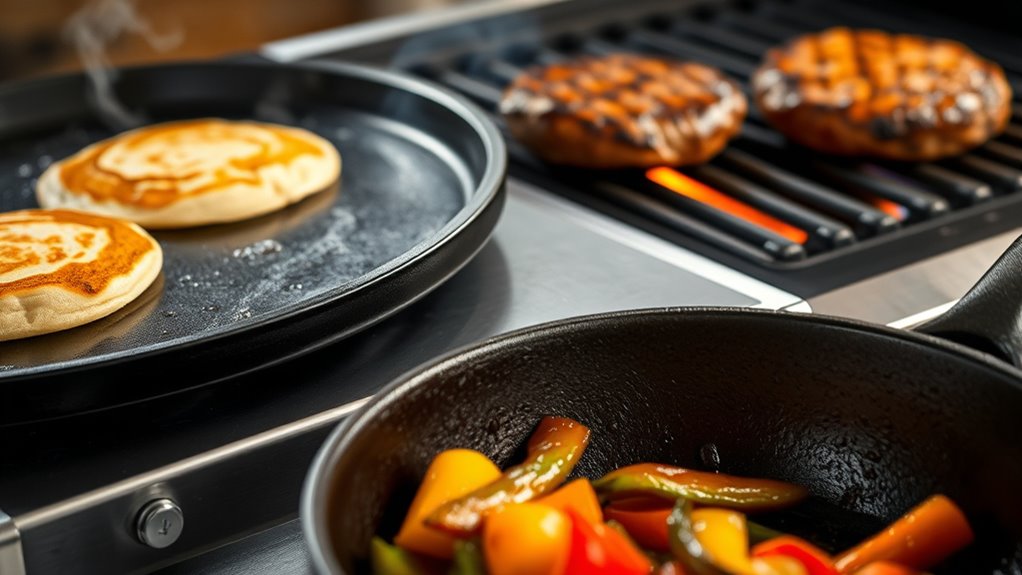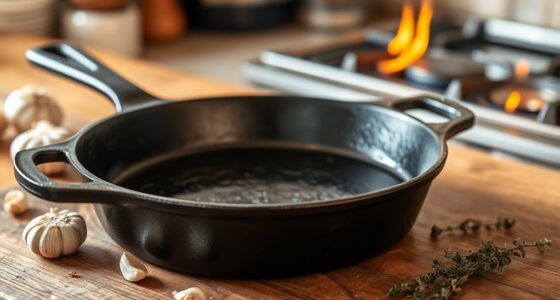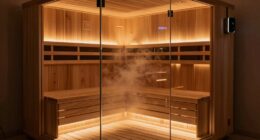To choose the right tool, consider what you’re cooking and the flavor you want. Use a pan, especially cast iron, for versatile everyday meals like sautéing or frying, knowing it offers excellent heat retention. Opt for a griddle when cooking large breakfasts or serving multiple people at once. A grill adds smoky flavor ideal for meats and veggies, making outdoor grilling a great choice. Keep exploring each option’s benefits to find the perfect fit for your culinary needs.
Key Takeaways
- Use a cast iron pan for versatile, everyday cooking like searing, sautéing, and frying with easy cleanup.
- Choose a griddle for large breakfasts or cooking multiple items simultaneously on a flat, spacious surface.
- Opt for a grill to add smoky flavor and grill marks, especially for outdoor cooking of meats and vegetables.
- Consider material and coating: cast iron offers durability and natural non-stick, while non-stick pans are easier to clean.
- Match the tool to your meal type, cooking style, and convenience needs for optimal culinary results.

Have you ever wondered how the right cooking tool can transform your culinary experience? Choosing between a griddle, grill, or pan depends on what you want to cook and how you prefer to cook it. Each tool offers unique benefits, and understanding their differences helps you make smarter choices for your kitchen.
Let’s start with pans, which are versatile and essential. A good pan can be made from various materials, but cast iron is a standout, especially if you’re after durability and heat retention. Cast iron pans are known for their longevity and ability to develop a natural non stick coating over time. Once seasoned properly, they create a smooth, almost non stick surface that’s perfect for searing steaks, sautéing vegetables, or frying eggs. Plus, cast iron distributes heat evenly, giving you more control over your cooking. If you prefer a non stick coating from the start, many modern pans come with ceramic or PTFE coatings, making cleanup easier. However, keep in mind that non stick coatings can wear out over time or get damaged if you use metal utensils, so choosing a high-quality pan and handling it with care can prolong its lifespan.
Cast iron pans are durable, heat-retentive, and develop a natural non-stick surface over time.
Moving beyond pans, a griddle offers a broad, flat surface that’s ideal for breakfast foods like pancakes, bacon, and eggs. It’s perfect when you want to cook multiple items at once or serve a crowd. Griddles, whether electric or stovetop, provide consistent heat across a large area, which simplifies cooking multiple servings and keeps everything warm until you’re ready to eat. Their flat surface minimizes flipping and turning, reducing the risk of food sticking or breaking apart. For outdoor cooking, electric or propane-powered griddles are convenient and portable, making them great for patios or camping trips.
Then there’s the grill, which excels at imparting smoky flavors and grill marks. Grilling is perfect for meats, vegetables, and even fruits, giving them a charred, delicious taste. Grills come in different styles—charcoal, gas, or electric—each offering a different experience. The high heat of a grill can be tricky to control but produces a unique flavor unmatched by other tools. If you’re aiming for that authentic smoky taste and appealing grill marks, choosing the right grill is essential. Keep in mind, a grill’s open flame and heat can make cleaning more challenging, especially if you’re grilling frequently.
Ultimately, your choice depends on what you value most in your cooking. A cast iron pan with a non stick coating can be your go-to for many everyday dishes, combining durability with easy cleanup. But for large breakfasts or outdoor gatherings, a griddle or grill might be the better option. Knowing the strengths of each tool allows you to select the right one for your culinary adventures, making every meal more enjoyable and efficient.
Frequently Asked Questions
Can I Use a Griddle for Baking or Roasting?
You can’t use a griddle for baking or roasting directly, but it can serve as a baking alternative for certain recipes like flatbreads or pancakes. For roasting options, a griddle isn’t ideal because it doesn’t provide the oven’s even heat and airflow. If you’re looking for baking alternatives, consider using an oven or a baking sheet. For roasting, stick with a traditional oven or roasting pan for best results.
Are Non-Stick Coatings Safe for High-Temperature Cooking?
You might imagine a gentle dance, but high temperatures can challenge non-stick safety. Many non-stick coatings are safe for everyday cooking, yet they can degrade or emit fumes if heated excessively. For high-temperature cookware, look for options labeled as oven-safe or designed for high heat. Always follow manufacturer instructions to guarantee safe usage, and consider alternatives like cast iron for intense heat, keeping your cooking both safe and effective.
How Do I Clean and Maintain a Cast Iron Pan?
To clean and maintain your cast iron pan, start by rinsing with hot water and scrubbing with a stiff brush or salt for stubborn residue. Avoid soap; instead, dry thoroughly to prevent rust. Regularly season your pan by applying a thin layer of oil and heating it. For rust removal, scrub with steel wool and re-season. Proper cleaning methods guarantee your cast iron stays non-stick and rust-free.
Is a Grill Suitable for Cooking Delicate Fish?
A grill can be suitable for cooking delicate fish if you handle it carefully. The grill flavor adds a smoky depth, but you need to prevent the fish from sticking or tearing. Use a well-oiled, hot grill and consider a fish basket or foil to protect the delicate flesh. This way, you enjoy the grill flavor while keeping your fish intact and delicious.
Can I Use a Pan on an Induction Cooktop?
Yes, you can use a pan on an induction cooktop if it’s induction compatible. Think of your cooktop as a dance floor that only welcomes partners with a certain rhythm—your pan’s material is key. Look for cookware made of magnetic materials like cast iron or certain stainless steels. If the bottom sticks to a magnet, you’re good to go, ensuring efficient heating and safe cooking.
Conclusion
Now that you know the differences, choosing between a griddle, grill, or pan becomes easy. Think of the grill’s smoky flavor versus the pan’s quick versatility—each offers a unique experience. The griddle, with its spacious surface, invites you to cook breakfast for a crowd. So, whether you crave the charred taste or the perfect sear, selecting the right tool transforms your cooking from ordinary to exceptional. After all, the right tool makes all the difference.









